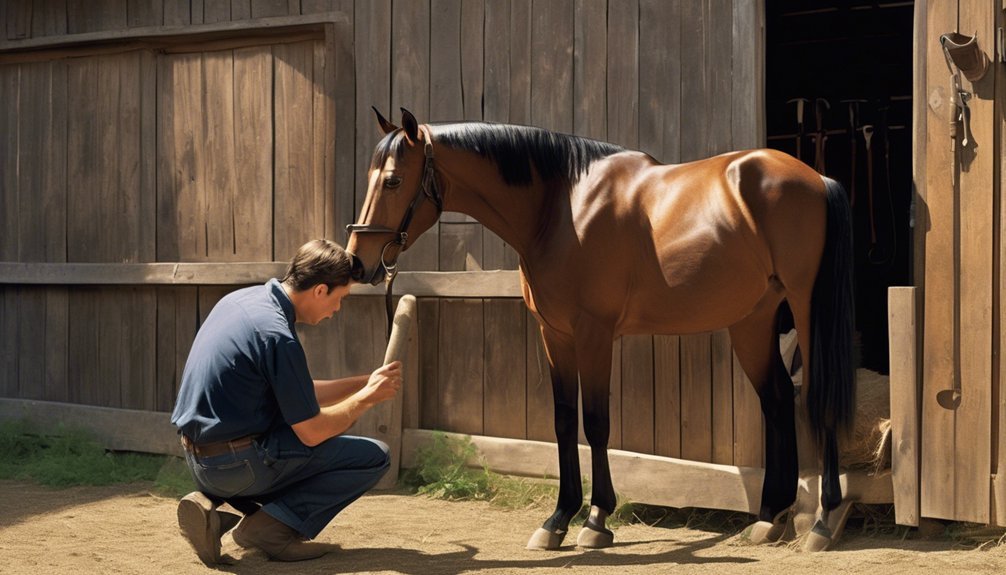
Imagine a horse named Bella, who flinches at the slightest touch during grooming. You can help her overcome this anxiety with the right techniques. By understanding her behavior and creating a calm environment, you can make grooming a more positive experience for both of you. But where do you start, and what tools should you use? Let's explore the best approaches to ease nervous horses like Bella into a comfortable grooming routine.
Key Takeaways
- Create a calm environment with soft lighting, gentle music, and soothing scents to help ease your horse's nerves during grooming.
- Start with simple trust exercises, rewarding your horse with praise or treats for approaching you and allowing contact.
- Gradually introduce grooming tools, beginning with a soft bristle brush to build comfort and trust before using other tools.
- Pay attention to your horse's body language; recognize signs of stress like pinned ears or rapid eye movement and adjust your approach accordingly.
- Use positive reinforcement consistently, rewarding calm behavior throughout the grooming session to encourage a positive experience.
Understanding Your Horse's Behavior
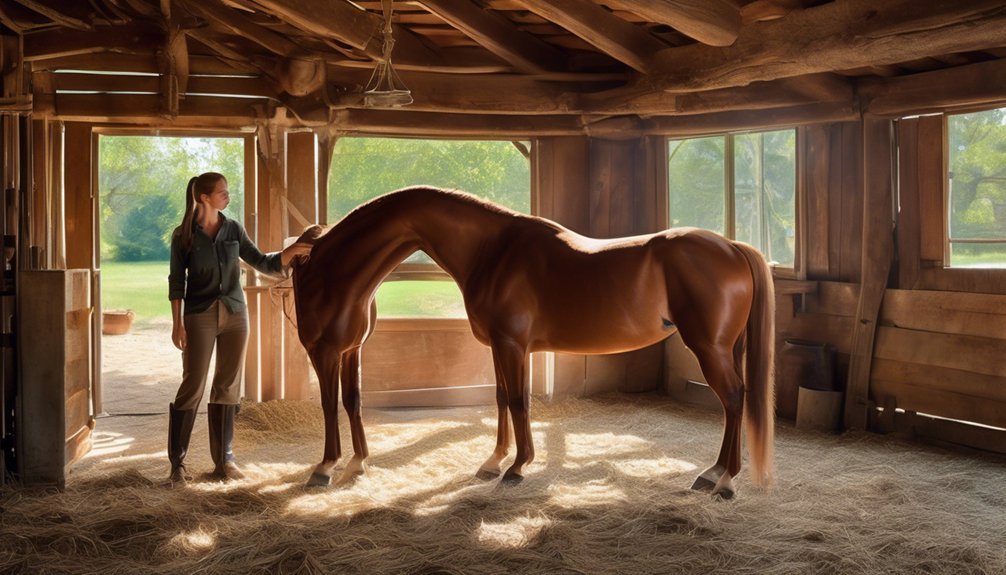
How well do you really understand your horse's behavior? Recognizing your horse's body language is essential for building trust and creating a calming atmosphere.
Pay attention to their ears; if they're pinned back, it might indicate discomfort or irritation. Notice how they shift their weight, as these movements can reveal anxiety or excitement. Understanding behavioral triggers, like sudden noises or unfamiliar surroundings, helps you anticipate their reactions, fostering a deeper bond.
When you approach grooming, being aware of these signals allows you to adjust your techniques, ensuring your horse feels safe and secure. Engage patiently, and over time, you'll develop a profound connection, making grooming a more enjoyable experience for both of you.
Setting the Right Environment
Creating a calm and inviting space for grooming can significantly enhance your horse's experience. Choose a quiet area away from distractions, where your horse feels safe and comfortable.
Soft lighting and a clean grooming space can help soothe their nerves. Consider incorporating calming scents like lavender or chamomile, which can create a relaxing atmosphere for both you and your horse.
As you work, speak softly and reassuringly, allowing your horse to acclimate to the environment. You might even play gentle music to further ease any anxiety.
Building Trust Through Positive Reinforcement
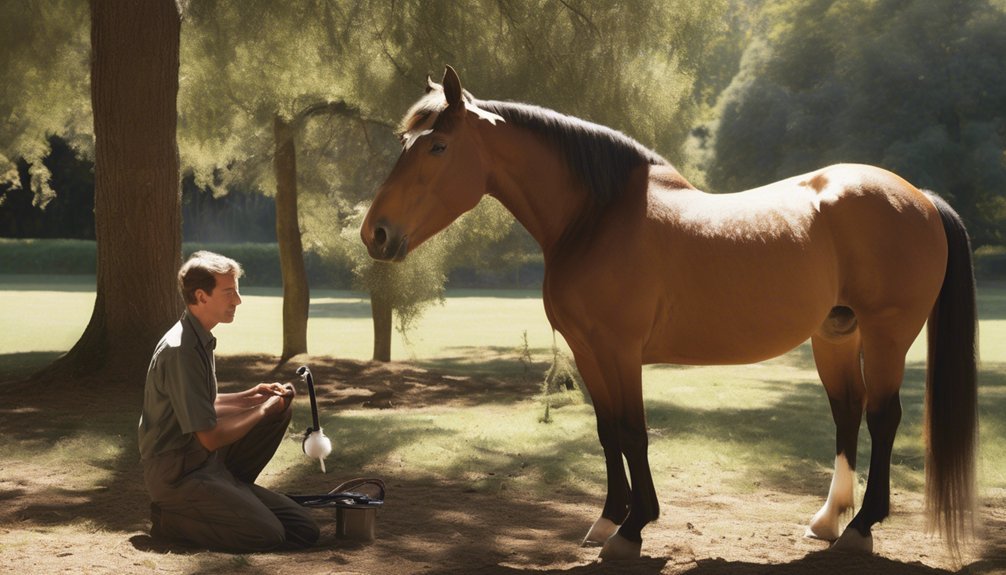
Building trust with your horse is essential for a positive grooming experience, especially when you use positive reinforcement techniques.
Start with simple trust exercises, like allowing your horse to approach you at their own pace. When they make brave choices, reward them with gentle praise or a treat. This builds a solid foundation of trust.
Establish a consistent reward system, so your horse associates grooming with positive outcomes. Gradually introduce grooming tools while rewarding calm behavior.
Remember, patience is key; every small step forward is a victory. Celebrate those moments to deepen your connection.
Over time, as your horse learns to trust you, you'll find grooming transforms into a bonding experience, enhancing both your relationship and their comfort.
Choosing the Right Tools for Grooming
Selecting the right grooming tools is crucial for both your horse's comfort and your efficiency.
Using the appropriate horse brushes and tools can make a significant difference in your grooming experience. Here are some essentials to consider:
- Soft bristle brush: Gentle enough for sensitive areas, ensuring a comfortable experience.
- Curry comb: Great for loosening dirt and hair, helping you maintain a shiny coat.
- Hoof pick: Essential for checking and cleaning hooves, keeping them healthy.
- Fleece or microfiber cloth: Perfect for a final touch, leaving a beautiful shine.
Approaching Your Horse Calmly
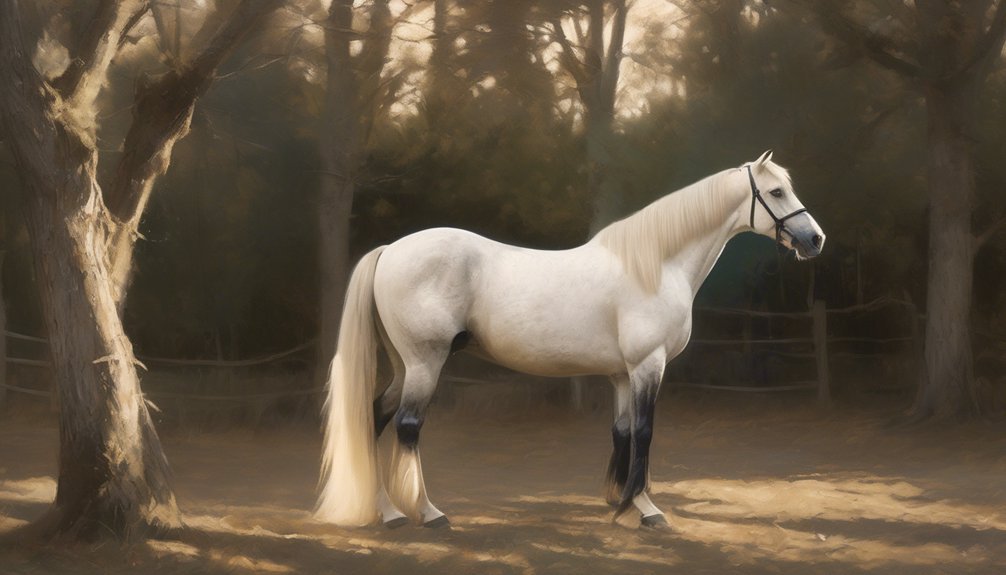
Approaching your horse calmly is essential for establishing trust and ensuring a positive grooming experience.
Start by being mindful of your body language; move slowly and avoid sudden gestures that might startle your sensitive friend. Your calming presence can work wonders, creating an atmosphere where your horse feels safe.
Speak softly, using a gentle tone to let your horse know you're there to help, not to harm. Make sure to maintain eye contact, as this shows your horse that you're engaged and attentive.
As you get closer, offer your hand for a sniff, allowing them to become familiar with your scent. This simple approach fosters connection and reassurance, paving the way for a more enjoyable grooming session.
Techniques for Gentle Grooming
Gentle grooming techniques can make a world of difference in your horse's comfort and trust.
By using soothing techniques, you can create a calming experience that strengthens your bond.
Here are some gentle grooming methods to try:
- Gentle brushing: Use a soft-bristled brush to avoid startling your horse.
- Slow strokes: Move your hand in slow, deliberate motions, allowing your horse to relax.
- Whispering touch: Lightly run your fingers along their coat, mimicking a gentle caress.
- Frequent pauses: Stop occasionally to give your horse a chance to breathe and adjust.
The Importance of Routine

Establishing a grooming routine is essential for both you and your horse, as it fosters trust and familiarity.
By sticking to a consistent grooming schedule, you create a safe space where your horse can relax and feel secure. Routine benefits your bond, making it easier for your horse to anticipate your actions and respond positively.
You'll notice how your gentle touch becomes a source of comfort, easing any nervousness. This regularity also allows you to monitor your horse's health more effectively, catching any changes early on.
Recognizing Signs of Stress
Stress in horses can manifest in various ways, and being able to recognize these signs is crucial for their well-being.
Pay close attention to your horse's body language and look for common stress signals, as they can help you understand their emotional state.
- Ears pinned back or constantly flicking
- Rapid eye movement or wide eyes
- Tension in their muscles or tail swishing
- Increased breathing rate or sweating
Gradual Exposure to New Experiences
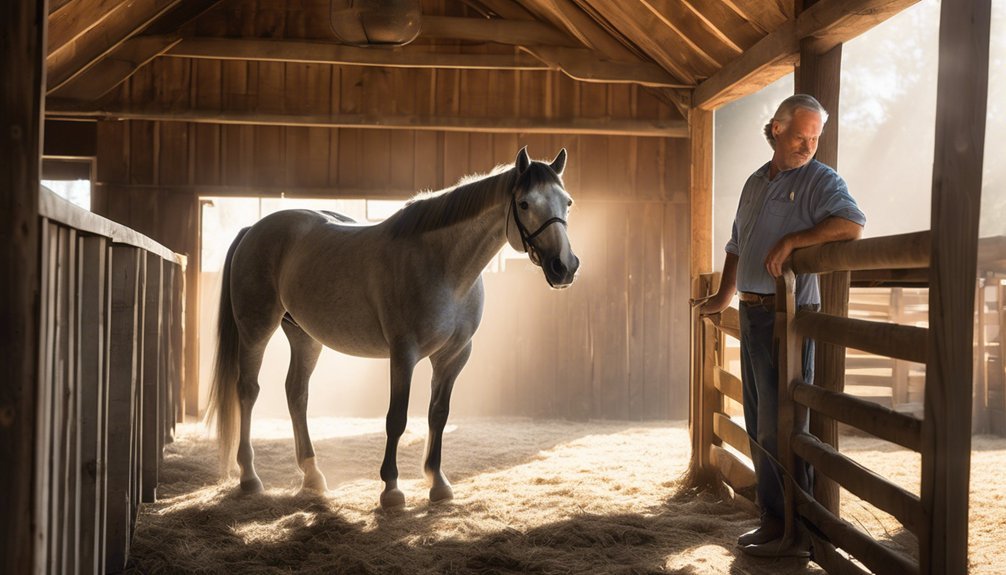
Recognizing your horse's stress signals is the first step in fostering a positive relationship.
To help your nervous horse, use desensitization methods through a gradual introduction to new experiences. Start with low-stress environments, allowing your horse to explore at their own pace. Introduce unfamiliar objects—like grooming tools or new sounds—slowly, giving them time to adjust.
Be patient and offer reassurance with soothing words and gentle touches. As your horse becomes more comfortable, gradually increase the intensity of these experiences.
Celebrate small victories together, reinforcing their trust in you. This approach not only builds confidence but also deepens your bond, making grooming and handling much more enjoyable for both of you.
Frequently Asked Questions
Can Grooming Help Reduce My Horse's Anxiety Levels?
Absolutely, grooming can significantly help reduce your horse's anxiety levels. The soothing touch and routine create a comforting bond, while the grooming benefits promote relaxation, making your horse feel safe and secure in your presence.
How Often Should I Groom a Nervous Horse?
Imagine softly brushing your horse, creating a calming rhythm. Establish a gentle grooming schedule, ideally daily, to help alleviate anxiety triggers. Consistency fosters trust, allowing your bond to deepen as you both embrace tranquility together.
What Should I Do if My Horse Bites During Grooming?
If your horse bites during grooming, identify the biting triggers. Approach with patience, using safe handling techniques. Create a calm environment, and build trust slowly. Remember, it's about connection, not just grooming. Take your time.
Are There Specific Brushes for Sensitive Areas on a Horse?
Imagine gently caressing a delicate flower; that's how you should approach grooming. For sensitive areas, use soft, sensitive brushes and gentle grooming techniques. Your horse will appreciate your kindness and trust you more over time.
How Can I Tell if My Horse Enjoys Grooming?
You'll notice your horse enjoys grooming by observing body language cues—relaxed posture, lowered head, or soft eyes. Pay attention to grooming preferences, like favorite spots, as these signals reveal your horse's comfort and happiness.
Conclusion
Grooming a nervous horse is like building a delicate bridge; it takes patience and care to connect with them. By understanding their behavior and creating a calm environment, you can foster trust and comfort. Remember, each gentle stroke helps weave a bond that deepens over time. Stay attuned to their needs, and don't rush the process. With consistency and kindness, you'll transform grooming into a shared experience that both you and your horse cherish.





